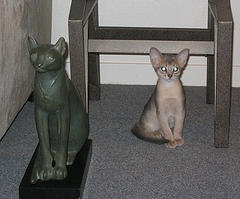
Egyptian Cat Art is interesting for me on the level of, “what cat breed is being portrayed”, in the numerous artifacts from ancient Egypt and, “how did they treat their cats”. The practical stuff as opposed to the art. One thing seems indisputable, the cat was very lucky in being the subject matter of the Eyptian’s veneration as it guaranteed a quality of life of the domestic cat the likes of which has probably not been seen before or since. Although all was not rosey in the garden as young cats were killed and sacrificed to the gods by the hundreds of thousands and 80,000 wild cats were dug up on the banks of the Nile. Not a good look in respect of cat welfare.
Egyptian Cat Art to me is very static and the sculptures are the kind of thing you might now see decorating buildings. It seems to have been a more practical form of art instead of something created for art’s sake.

This may be the case because they worshiped their cats. Cats had a significance far beyond companionship or rodent catcher level. This reverence for the cat is reflected, perhaps, in the quiet, formal and statuesque works of art.
We know that Egyptians loved their cats. It seems to have been a golden age for cats. The modern age is also a good time for cats in the Western World as is evidenced by the gradual increase in the number cat breeds and the growing cat fancy and most startlingly the explosion in the number pet cats.
My research tells me that there were about 23 million cats in the USA in the mid 1980s. In 2007 there are, in the order of, 90 million, apparently. Some thought perhaps needs to go into the increase in the domestic cat population rather than letting things take their own course.
Cats in ancient Egypt were considered sacred (meaning: set apart for religious use, made or declared holy); they were the sacred cat of the goddess Bastet.
The era of ancient Egypt was 3150 BC to 31 BC, when the Romans conquered and absorbed the area. The Romans, in expanding their empire, spread the domestic cat across Europe and into the UK. These cats are the ancestors to the British Shorthair.

The cat’s popularity at the time lasted for about 2000 years. The Bastet (the cat goddess was called Bastet) festivals were immensely popular. They lasted until AD 390.
Due to the esteem in which the cat was held the export of cats was banned but cats nonetheless were exported probably at a high price to areas around the Mediterranean sea.
All the Egyptian cat art statues from this era have a similar profile. By modern standards the face is a little long, with a long forehead leading to a longish muzzle. Of the many current breeds the most likely
 y match would seem to be the Abyssinian cat, which allegedly comes from Ethopia about 1000 kms south of Egypt. Or perhaps the Egyptian Mau which originates from about this era and of course from Egypt. See a cat history timeline.
y match would seem to be the Abyssinian cat, which allegedly comes from Ethopia about 1000 kms south of Egypt. Or perhaps the Egyptian Mau which originates from about this era and of course from Egypt. See a cat history timeline.
The Abyssinian is a natural breed with a long history. Her coat is suited to desert life, as well, being light light brown/gold coloured and ticked (broken salt pepper appearance). This would indicate to me that this breed originated from a wild cat that came from the desert regions of the middle east.
Of course the cat depicted in the statues need not be a true representation of the domestic cat at that time, but must be based on what the Egyptians thought a domestic cat should look like.
On the death of a cat they where buried by the million in vast cemeteries having been embalmed, carefully wrapped up and a face mask placed on the cat.

The embalmed cats wrapped up like this are, it could be argued, works of Egyptian cat art themselves.
This would indicate great care and respect for the cat at a time in the history of mankind when the world was generally less civilised than it is now. But was this the case, in fact? It would seem that domestic cats or perhaps semi-feral or feral cats were killed by breaking their necks. They were then preserved in salt and mummified and then given to pilgrims who had come to worhsip and make an offering to the god Bastet.
It would see that there is little change in the world if this is true as feral cats and even true domestic cats are are routinely killed the world over for all manner of reasons including cat meat, cat fur, to be rid of them or for fun.
Does this purported extra care come from a genuine tenderness towards the cat at that time or the need to please the god Bastet, who they thought protected them (or was it pure commercialism)?
Sources:
- Online dictionaries
- Desmond Morris – Catwatching for the idea
- Myself


Loved looking at your Egyptian cats because I love Egypt